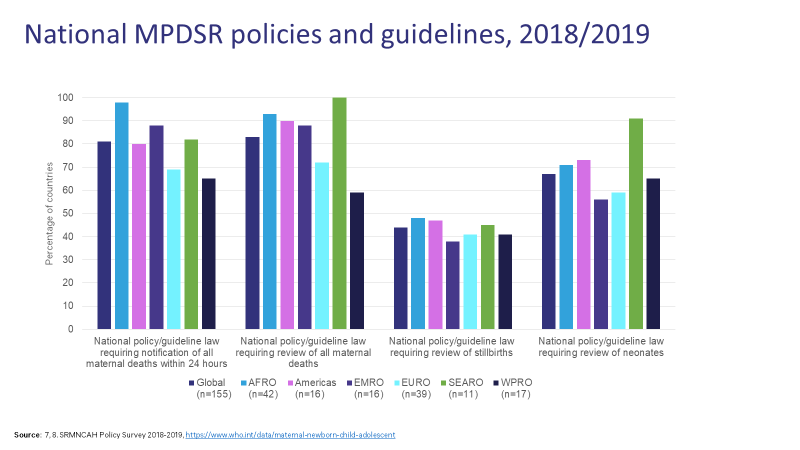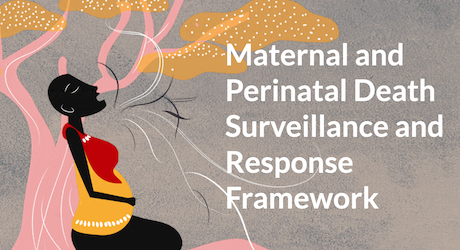Maternal and Perinatal Death Surveillance and Response
Overview
A key intervention for improving maternal, perinatal, and neonatal survival is understanding the number and causes of deaths. Systematic analyses of overall mortality trends, as well as events and contributing factors leading to individual deaths can identify health systems barriers and inspire local solutions to prevent such deaths in the future.
Maternal and perinatal death surveillance and response (MPDSR) is defined as an essential quality improvement intervention which permits the identification, notification, quantification and determination of causes and avoidability of maternal and neonatal deaths and stillbirth with the goal of orienting the measures necessary for their prevention. This definition also includes confidential enquiries, maternal death reviews, perinatal death reviews, maternal and perinatal death reviews and maternal death surveillance and response.
The primary goal of MPDSR is reducing future preventable maternal mortality through a continuous action and surveillance cycle followed by the interpretation of the aggregated information on the findings which is used for recommended actions that will prevent future deaths. MPDSR can also strengthen quality of maternal and newborn programmes as well as routine data systems such as Civil Registration and Vital Statistics (CRVS) and routine health information systems (RHIS).
MPDSR functions well in settings with a culture of accountability, learning and improvement. A culture of trust is nurtured by strong leadership and continuous re-assurance of a “blame-free culture”.
In 2013, the World Health Organization (WHO) launched the Maternal Death Surveillance and Response (MDSR) guidance to strengthen notification, review, and response to maternal deaths. This guide emphasizes the need for each maternal death to be a notifiable event and reviewed to be able understand the underlying causes to create a response mechanism to avert future deaths; a continuous cycle of surveillance and response.
National MPDSR policies and implementation
In the 2018/2019 WHO SRMNCAH Policy Survey, 81% of countries reported a national policy or guideline requiring notification all of maternal deaths within 24 hours, 83% of countries reported a national policy or guideline requiring review of all maternal deaths, and 67% of countries reported a national policy or guideline for review of neonatal deaths. However, less than half of countries (44%) reported a national policy or guideline requiring review of stillbirths. In 2015, WHO and UNFPA launched the Time to Respond report, which outlined the status of MDSR implementation. Results indicated strong political commitment and changes in national policies, but significant barriers to implementation including:
- Limitations around quality of reviews and appropriate coding causes of death
- Poor or absent perinatal death reviews
- Varied documentation and implementation of recommendations
- Poor linkages between MPDSR audits and quality improvement processes at facility level
- Lack of linkages between health information and civil registration and vital statistics
WHO has developed the MPDSR Materials to Support Implementation to address some of these barriers.

National MPDSR policies and guidelines_2018_2019
MPDSR materials to support implementation
In 2021 WHO published the new document “Maternal and Perinatal Death Surveillance and Response (MPDSR): materials to support implementation” to provide a roadmap for conducting MPDSR in clinical and policy settings.
This document is a practical step by step guidance, relevant to establish a framework to assess the burden of maternal deaths, stillbirths and neonatal deaths, including trends in numbers and causes of death and on how to link maternal and perinatal death reviews. It is important to generate information about modifiable factors contributing to preventable death, and to use the information to guide action in order to prevent similar deaths in the future. The document promotes confidentiality and a “blame free” culture fostering accountability for results and compelling decision-making.
MPDSR key documents
Maternal and perinatal death and surveillance and response
The purpose of the new WHO document “Maternal and Perinatal Death Surveillance and Response (MPDSR): materials to support implementation” is...
Implementation of maternal and perinatal death surveillance and response as part of quality of care efforts...
This knowledge brief is developed to support policy-makers, managers, practitioners and implementing partners engaged in improving quality of care (QoC)...
This standardized system for classifying stillbirths and neonatal deaths, aims to help countries link stillbirths and neonatal deaths to contributing conditions...
Making every baby count
Pregnancy is a time of great anticipation for all expectant parents and their families as they envision getting to know and love a healthy baby. The presence...

Time to respond: a report on the global implementation of maternal death surveillance and response (MDSR)
Understanding exactly why a woman died in pregnancy or around the time of childbirth is a crucial first step towards preventing other women dying in the...
Maternal death surveillance and response: technical guidance
Most maternal deaths are preventable. In order to end preventable maternal deaths, accurate information on how many women died, where they died and how...
The WHO application of ICD-10 to deaths during pregnancy, childbirth and puerperium: ICD MM
Reducing maternal mortality by 75% is the Millennium Development Goal 5a. To reach this goal, countries need an accurate picture of the causes and levels...
Making Every Baby Count: Audit and Review of Stillbirths and Neonatal Deaths
Around 2.4 million newborns die each year with about one third dying on the day of birth and close to three quarters dying within the first week of life; an additional 2 million are stillborn.1,2 The majority of deaths are preventable with well-known, evidence-based interventions.3
In 2016, WHO launched Making Every Baby Count: Audit and Review of Stillbirths and Neonatal Deaths, a guidance on implementation of perinatal audit and response as well as ICD-PM, a system for coding and classification of perinatal deaths using the international Classification of Diseases, update 10 (ICD-10).
- Levels and Trends in child mortality, Report 2019. New York; 2019.
- UNICEF, WHO, UNFPA, World Bank Group, United Nations Population Division, A Neglected Tragedy: The Global Burden of Stillbirths. New York; 2020
- Chou D, Daelmans B, Jolivet RR, Kinney M, Say L, Every Newborn Action P, Ending Preventable Maternal Mortality working: Ending preventable maternal and newborn mortality and stillbirths. BMJ 2015, 351:h4255.
MPDSR Technical Working Group
WHO convenes a global MPDSR Technical Working Group (TWG) to provide global guidance, develop tools, and facilitate country level implementation of MPDSR, coordinating with other monitoring platforms and initiatives.
Training material
Webinars
Related work














